On Tuesday evening, the Allianz Arena hosted a tantalising fixture between two European powerhouses, vying for a slim advantage on their journey to the final at Wembley.
A Champions League semi-final meeting between Bayern Munich and Real Madrid was sure to create fireworks, having both narrowly beaten English sides in the previous round.
The tactical battle between Thomas Tuchel and Carlo Ancelotti was fascinating, ultimately culminating in a fiercely contested fixture with moments of both footballing brilliance and crass decision-making, perfectly exemplifying the magnitude and emotion surrounding the match.
Real Madrid’s attacking flair was on full display as their ability to unlock defences with expressive and innovative play caused continued problems for Bayern’s defensive line.
However, the home side equally hurt Madrid with their dynamic playmakers and key tactical shifts from a manager who certainly knows how to navigate the latter stages of the Champions League.
The home side showed their gritty nature and swiftly found themselves ahead, only to be pegged back by another moment of magic from Vinicius Junior, a player who has rapidly grown accustomed to huge performances on these crucial European nights.
With the tie incredibly poised ahead of next week’s visit to Madrid, both Bayern and Real will aim to unpick the key moments from the match and look to mask potential weaknesses in order to meet either Borussia Dortmund or PSG in the final.
This tactical analysis will begin to address some of the key turning points in this contest, highlighting how both teams were able to exploit the other in an alarming fashion.
Our analysis will hone in on the tactics of both sides, showing how they were able to operate with effectiveness both in and out of possession.
Starting Line-ups
Bayern Munich looked to set up in their traditional 4-2-3-1 formation, with the ever-present Manuel Neuer between the sticks.
Their defensive line was comprised of Mazraoui, Dier, Kim Min-Jae and captain Joshua Kimmich, who operated as the right back.
Just in front of the defensive line was the double pivot of Leon Goretzka and Konrad Laimer, representing an expert balance of both offensive and defensive duties.
The Bayern attacking quartet was formed of Musiala and Sané aiming to cause trouble down the flanks while Thomas Müller and Harry Kane were left to occupy Madrid defenders in the central areas.
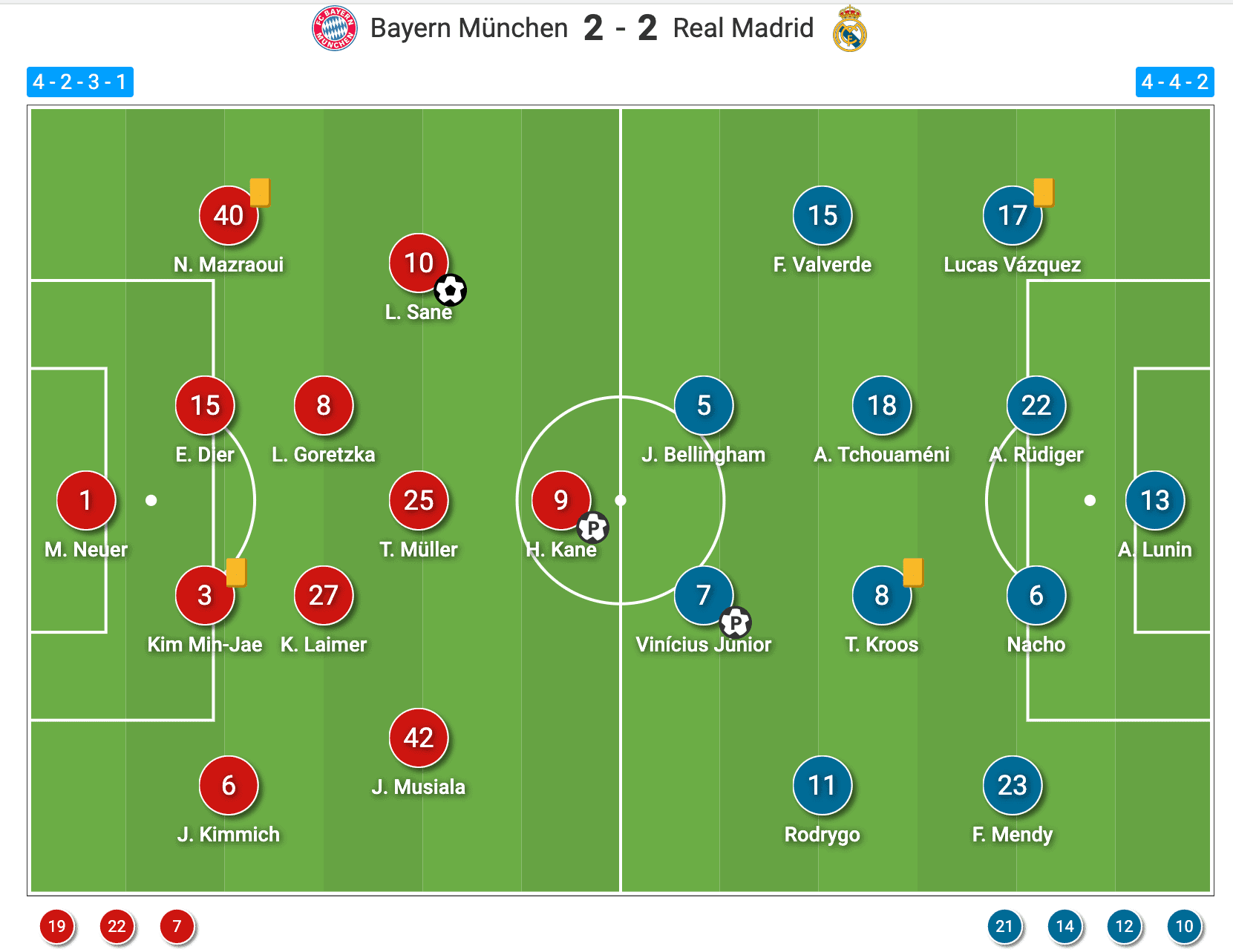
For the visitors, we saw the continued use of Ancelotti’s 4-4-2 diamond, a formation which has certainly illustrated their tactical freedom and ability to form meaningful chances out of nowhere.
Ukrainian goalkeeper Andriy Lunin maintained his starting berth, whilst long-term absentee Courtois aims to regain his fitness.
The Madrid defensive line was all too familiar, with Mendy, Rüdiger and Nacho being joined by Lucas Vázquez, a notable change replacing the suspended Carvajal.
Their midfield was made up of Toni Kroos, Federico Valverde, Aurelien Tchouaméni and English star Jude Bellingham.
This left the electric Brazilian pairing of Rodrygo and Vinícius Junior to lead the line for Los Blancos, with Bellingham and Rodyrgo interchanging in certain scenarios within the match.
Bayern Formation & Attacking Variability
The home side were immediately able to set the tone within the fixture, owing a lot to how Thomas Tuchel had set his side up in possession and be effective across the entire final third.
Bayern’s double pivot was incredibly important when looking to build from the back, with the movement of Laimer and Goretzka often confusing the marking assignments of the Real Madrid forwards.
By holding varied depths and Goretzka being more advanced, the front two of Madrid’s high block often had to decide whether they would sit on top of the defensive midfielders or press higher and look to cut out play from the centre backs.
This confusion allowed the likes of Laimer to drop in and create an overload on one side of the pitch, allowing space for the central defender and wing-back on the other side to progress should the ball be switched.
As we can see, Eric Dier can move the ball along the left flank with Madrid still reacting and reshuffling their defensive structure after being drawn towards the opposite side of the field.
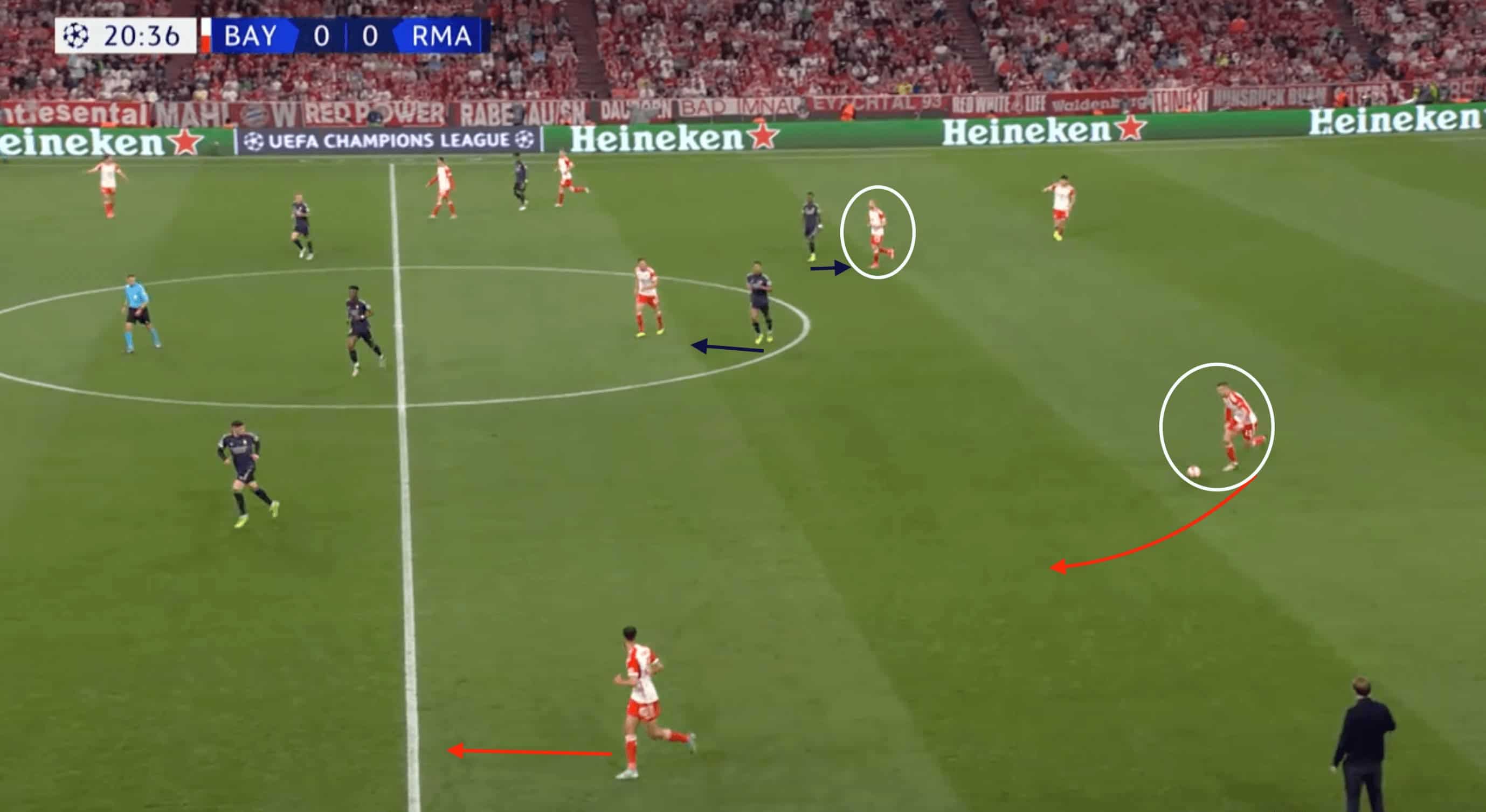
With Mazraoui and Kimmich operating higher up the flanks, Bayern showed immediate threat, with both Musiala and Sane having the freedom to drift inside to the half-spaces.
This allowed the explosive forwards to play closer to both Müller and Kane, creating important interchanges to break the lines, as shown below when Rüdiger was in two minds about whether or not to track the run of Sane or give Kane freedom to work the ball on the edge of the penalty area, ultimately resulting in an early key chance for the German winger.
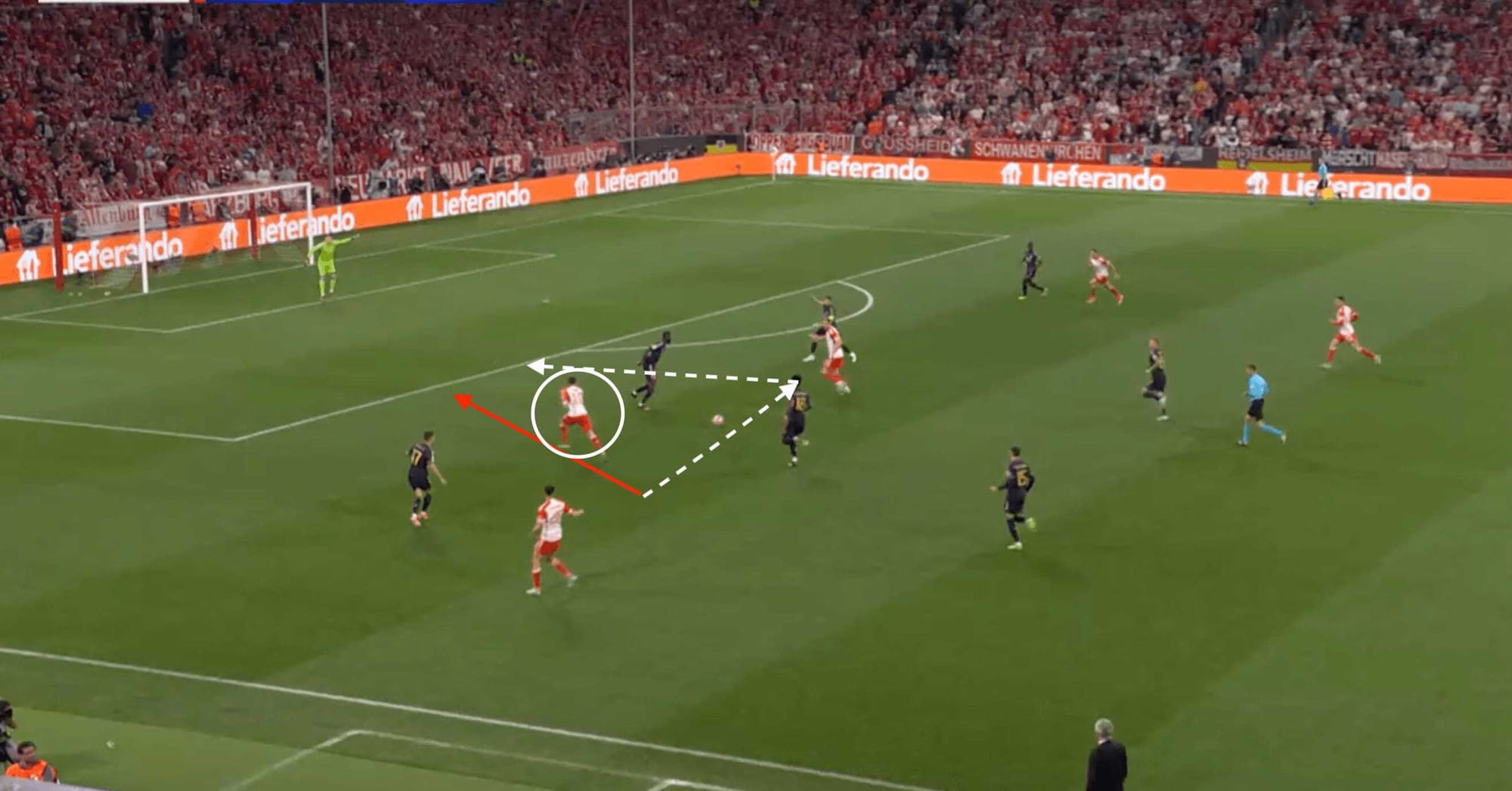
Tuchel’s key change
However, when Bayern’s attacking efforts came up fruitless, and Madrid found themselves in front going into the break, Tuchel identified a vital switch that would bring them back into the tie.
A decision to switch Musiala and Sané allowed them to be more effective driving inside the pitch on their stronger foot- but his half-time substitution was arguably more impactful.
Having introduced Guerreiro for Goretzka at halftime, this allowed Bayern to switch to a 4-3-3 in possession with Konrad Laimer as the lone single-pivot after an impressive defensive performance on the night.
This then caused Müller to drop deeper, with him and Guerreiro operating as the two advanced eights, ultimately creating further trouble for Madrid with more bodies in the central areas.
Their ability to stretch what was a narrow Madrid defensive line meant that Bayern found much more freedom out wide.
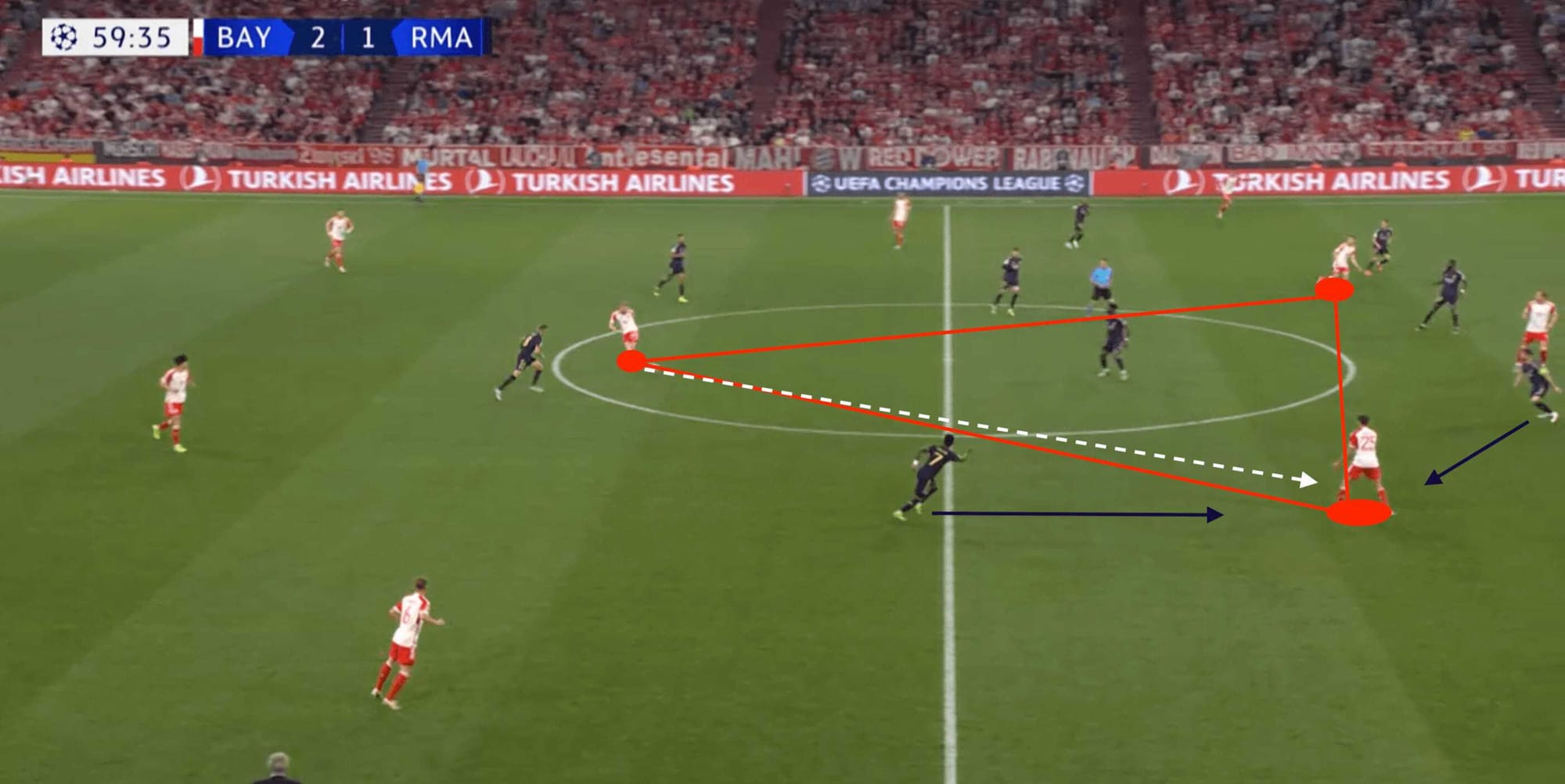
This had a significant influence on both Bayern goals.
Müller’s ability to manipulate the Madrid defenders’ defensive positioning created a clear 1v1 opportunity for Sané to attack—cutting inside and firing past Lunin.
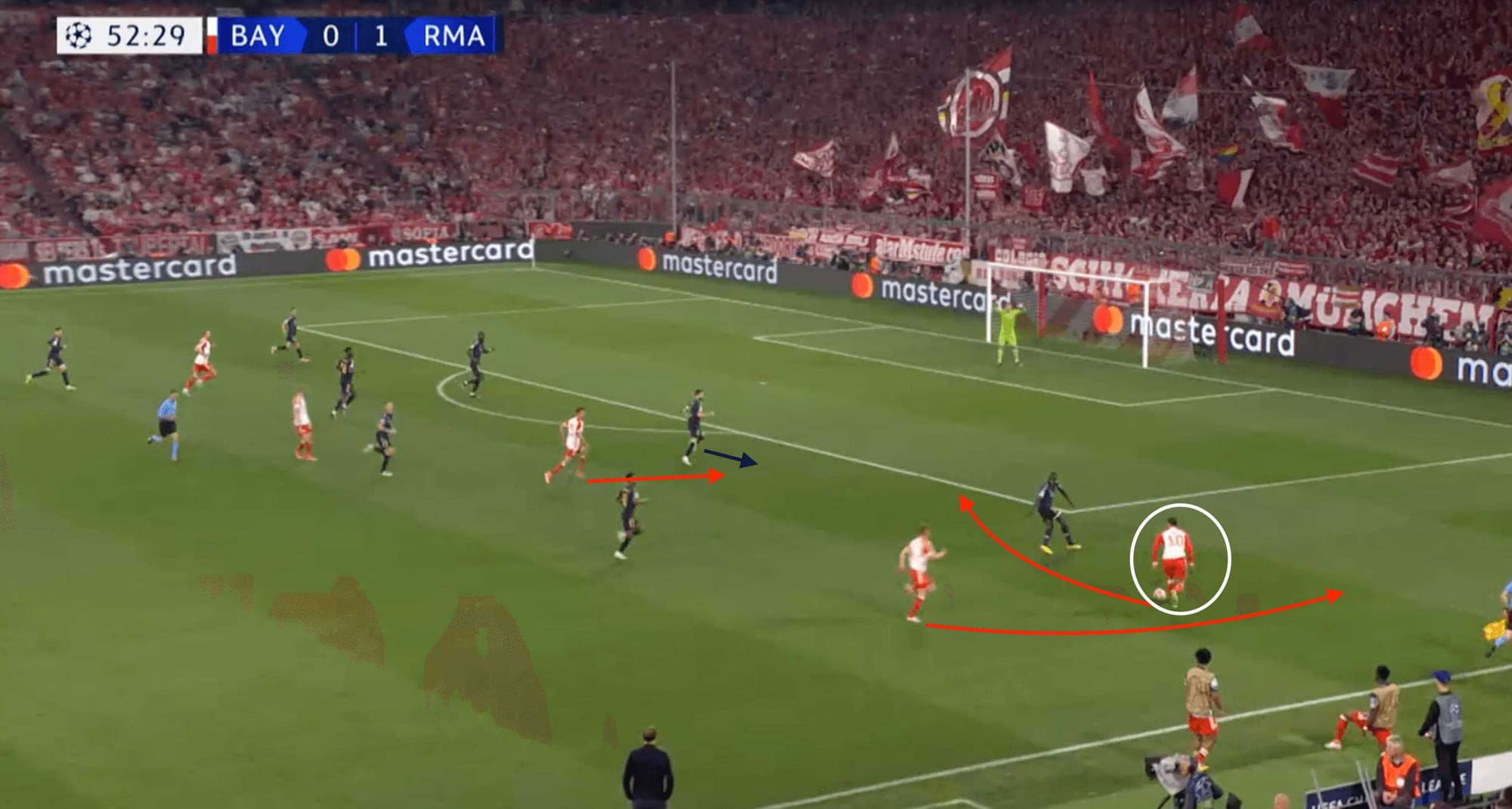
Guerreiro’s off-the-ball running and darting movement between Rüdiger and Vázquez created acres of space for Musiala to receive on the left, with the Madrid full-back conceding the penalty from a reactionary and desperate attempt to get back across and stop the danger.
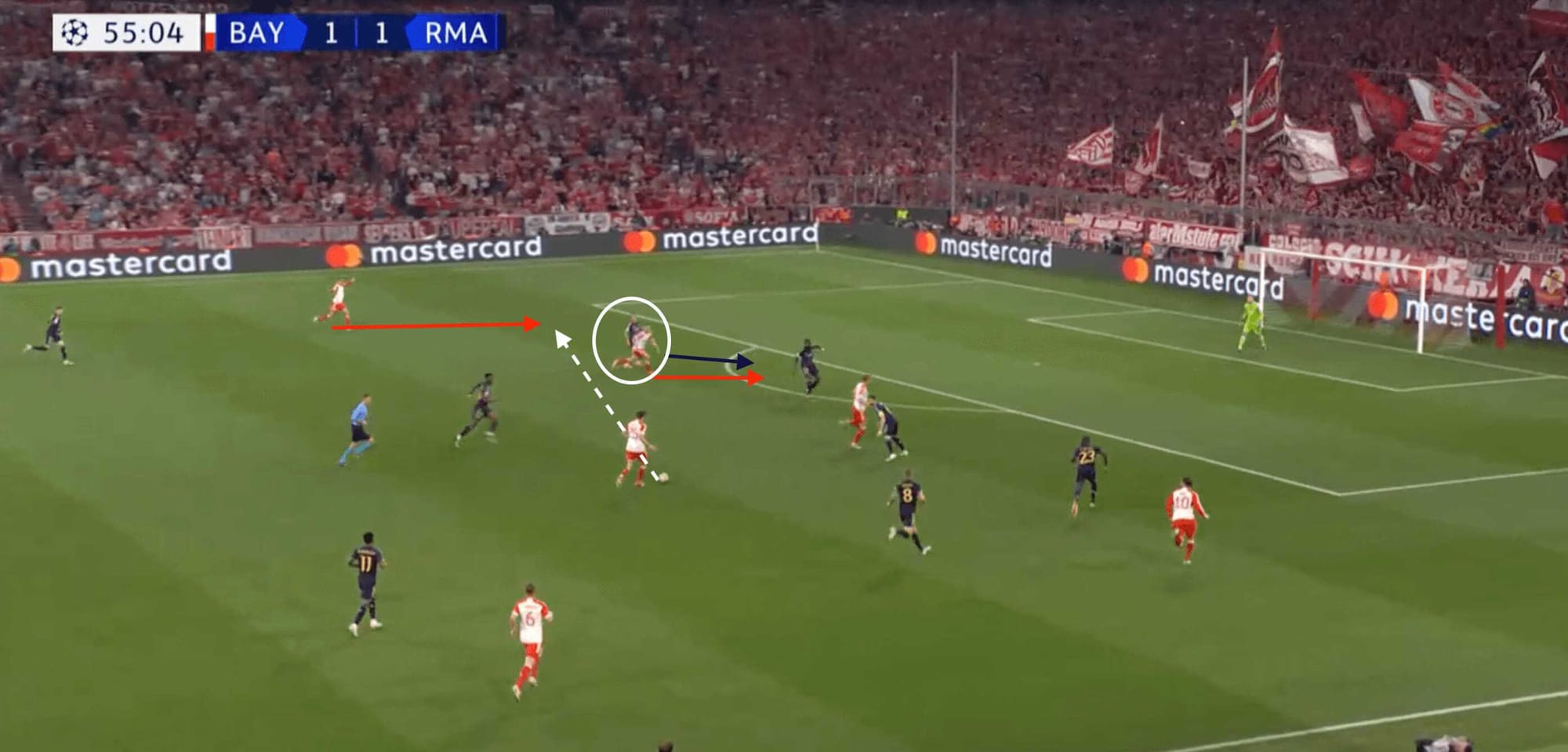
The Real Response
After weathering the early Bayern storm, Ancelotti’s team was able to grow into the match and made key defensive changes that limited the effectiveness of the Bayern playmakers.
When Bayern had their early dominance, Real Madrid’s lines were far too stretched, with huge gaps for Sane to drive into, and Harry Kane came deeper to receive and link play.
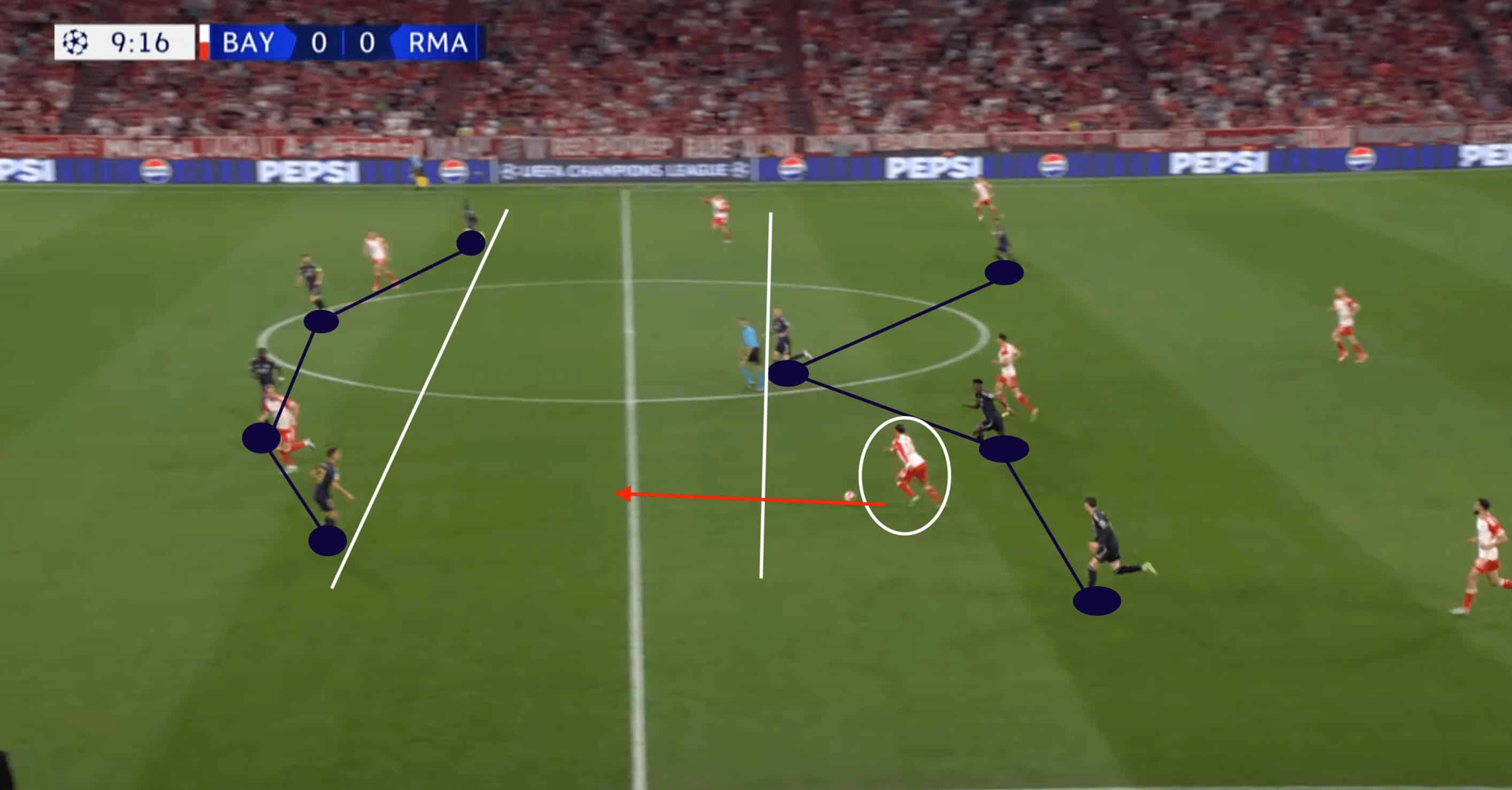
To combat this, Kroos and Tchouaméni were seen to play much tighter to their defensive line in an attempt to reduce Bayern’s attacking freedom and space.
Real Madrid could afford to do this and remain a threat on the counter-attack, with more opportunities to suffocate Bayern’s play and launch fast breaks in transition.
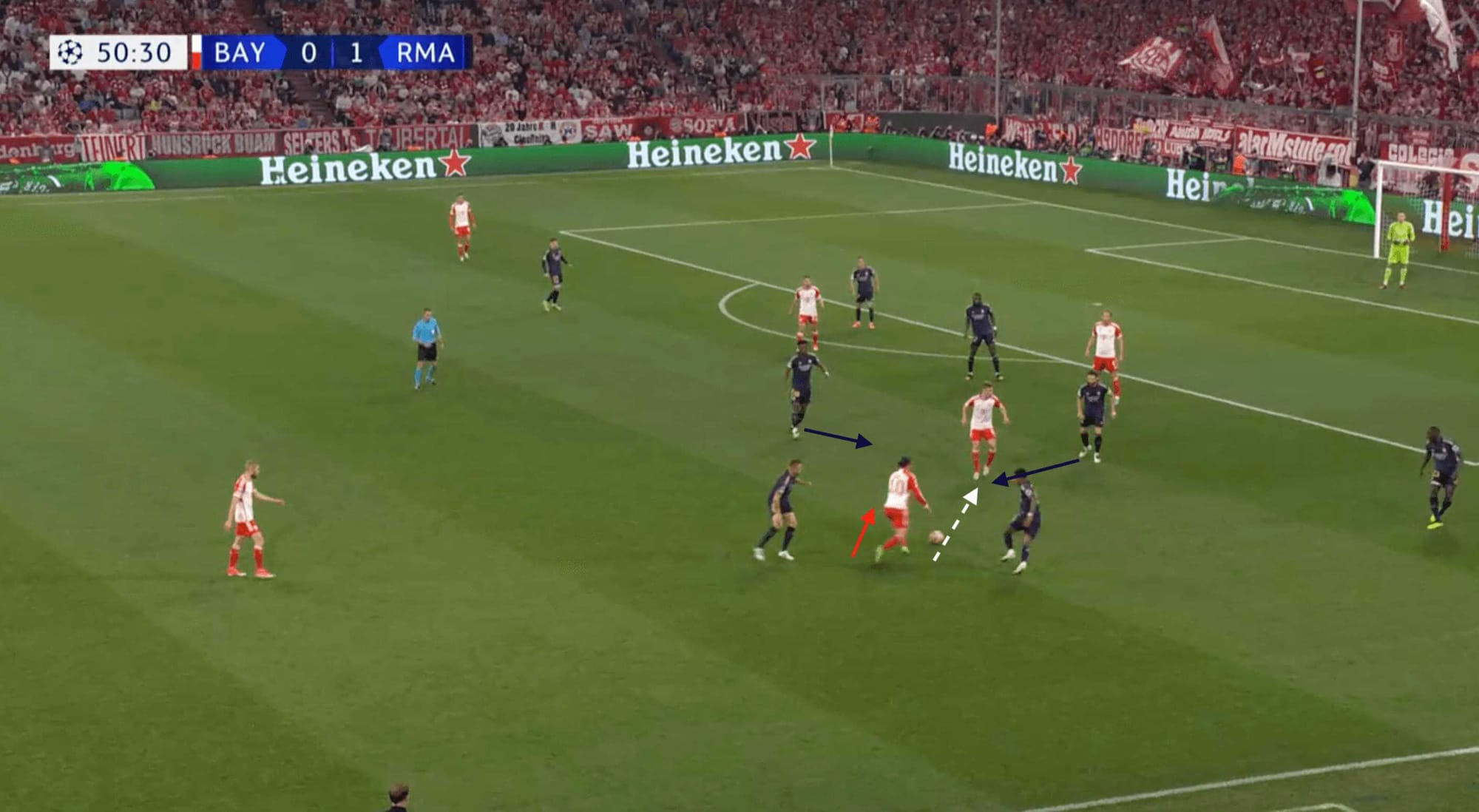
In the offensive phase, the movements of their midfielders were imperative to their success within the final third.
With the Madrid full-backs playing high and wide in possession, we saw Kroos dropping deeper to receive the ball and shifting across towards the flanks to cover that open space.
This gave him the chance to be the deep-lying playmaker, which eventually unlocked the Bayern defence for the opening goal.
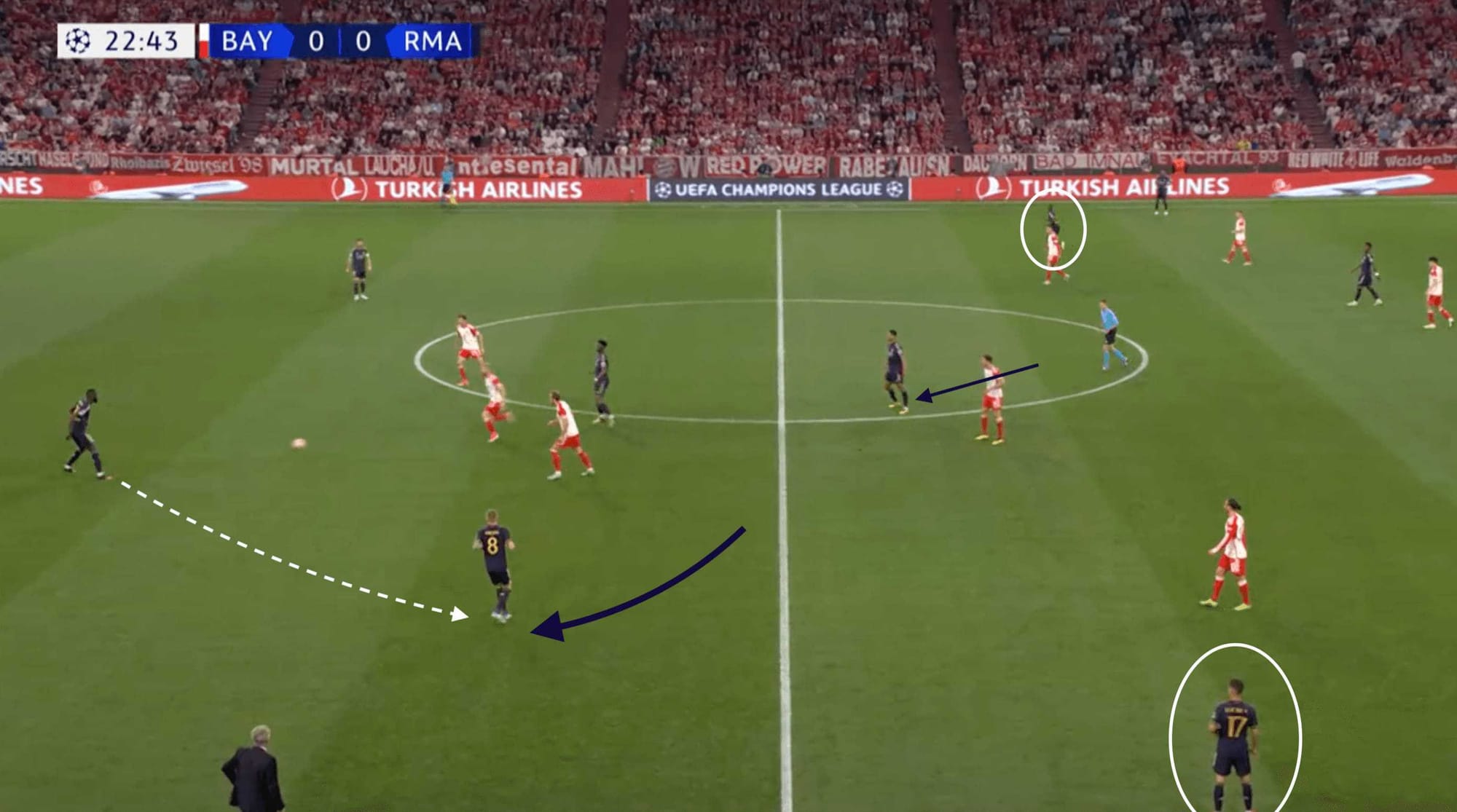
The movements of Bellingham and Tchouaméni also cannot be understated when looking at Madrid’s opener, with the Frenchman, in particular, vacating a comfortable position to advance and draw Konrad Laimer with him and create a key passing lane between Kroos and Vinícius Jr.
Bellingham’s propensity to be a nuisance in the final third grabbed the attention of Kim Min-Jae, who was initially drawn to the Englishman before realising Vinícius Jr had already gained that crucial first step over the Korean.
The defending that unfolded was ultimately a desperate attempt to regain control, which proved to be detrimental as the Brazilian found all the time in the world to slide the resulting pass into the bottom corner.
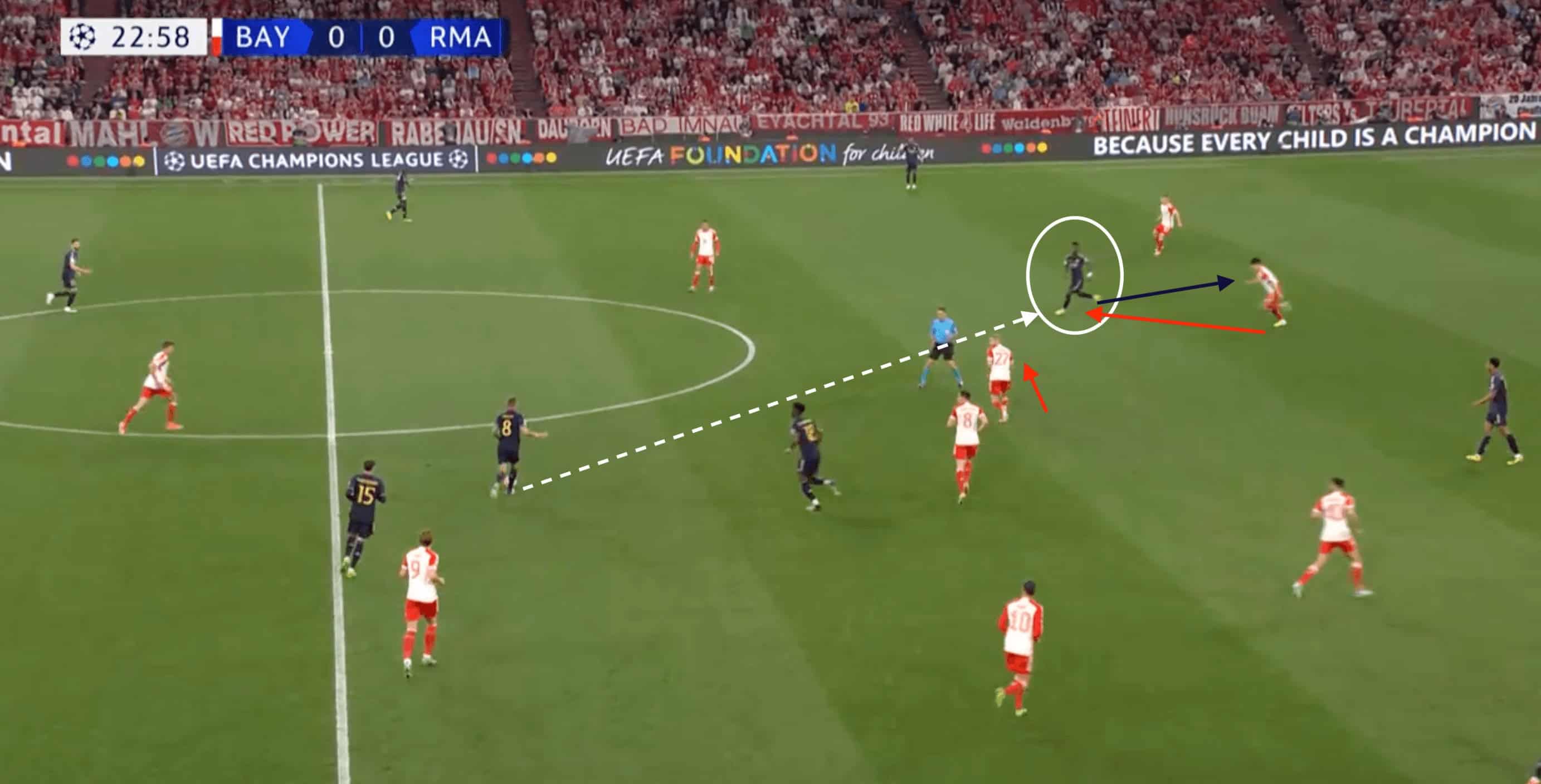
Overly aggressive defending
With Kim Min-Jae under the spotlight as the cause of both Real Madrid goals, his overall performance depicted a night of over-aggressive defending for the Bayern back line.
On a night with incredible implications for the rest of the season, the occasion appeared to get the best of the Bayern central defensive pairing.
Kim’s positioning failed to recognise neat, inventive play between Madrid’s two Brazilian forwards, forcing the Korean to haul down Rodrygo in the penalty area.
Bayern were incredibly lucky not to be punished once again, with their centre-backs looking to press high and negate space for the forwards to control.
Eric Dier was caught lacking when he aimed to aggressively win the aerial duel against Valverde, only for the Uruguayan to flick the ball on and Bellingham drive into the space which Dier had vacated.
This almost resulted in a Madrid penalty after a last-ditch Mazraoui foul.
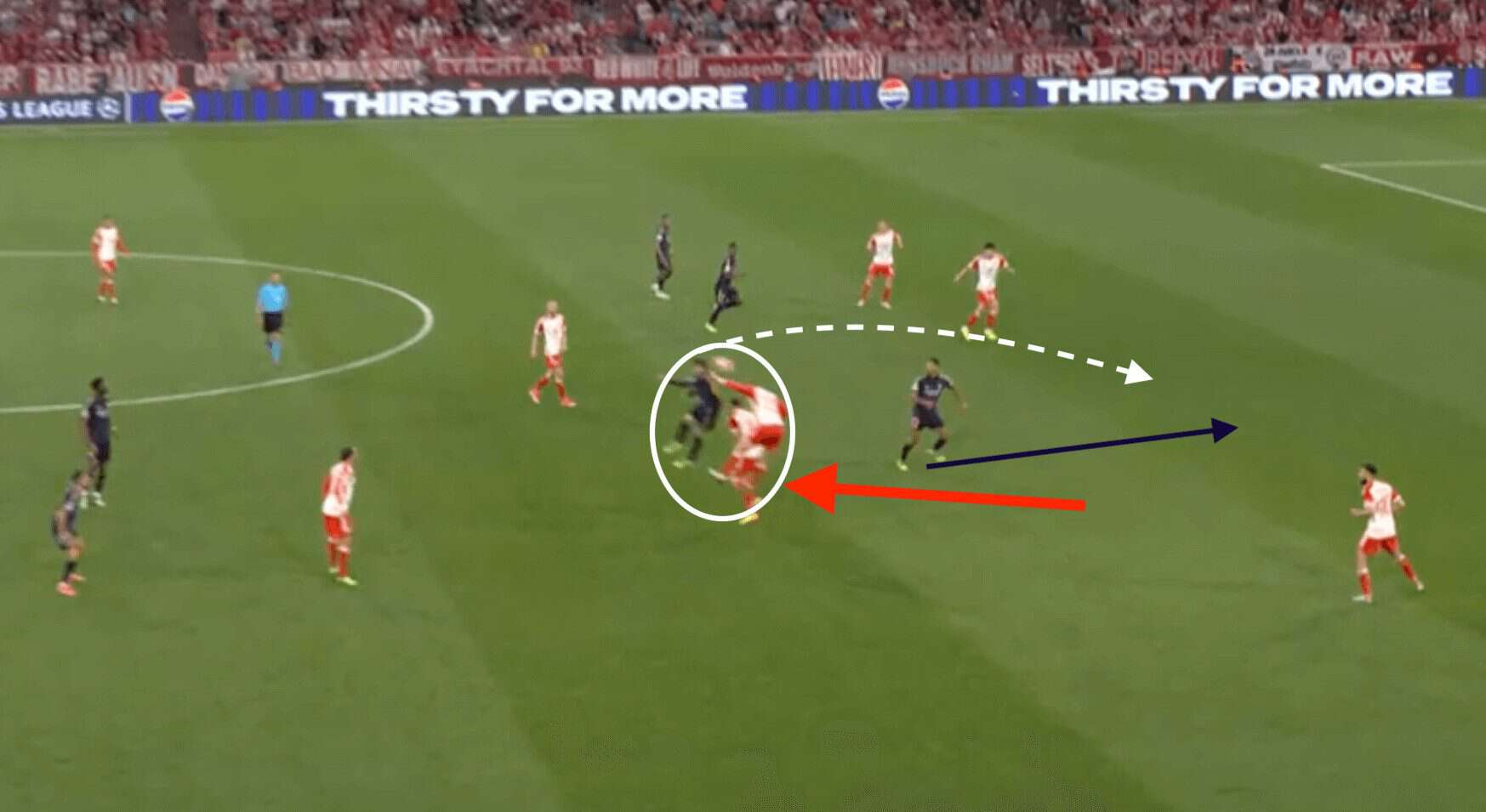
The decision to step up and be aggressive would appear to have stemmed from the increased space between Bayern’s double pivot and their central defenders, which was evident in Madrid’s opener and forced Kim’s hand to come and press.
It would appear that early success may have played a part in his future decision-making, with Kim intercepting Tchouaméni’s pass into the feet of Vinícius Jr and launching a swift Bayern counter.
However, a game of this magnitude requires a level of maturity and recognition of opposition threat which came all too late before Bayern found themselves behind.
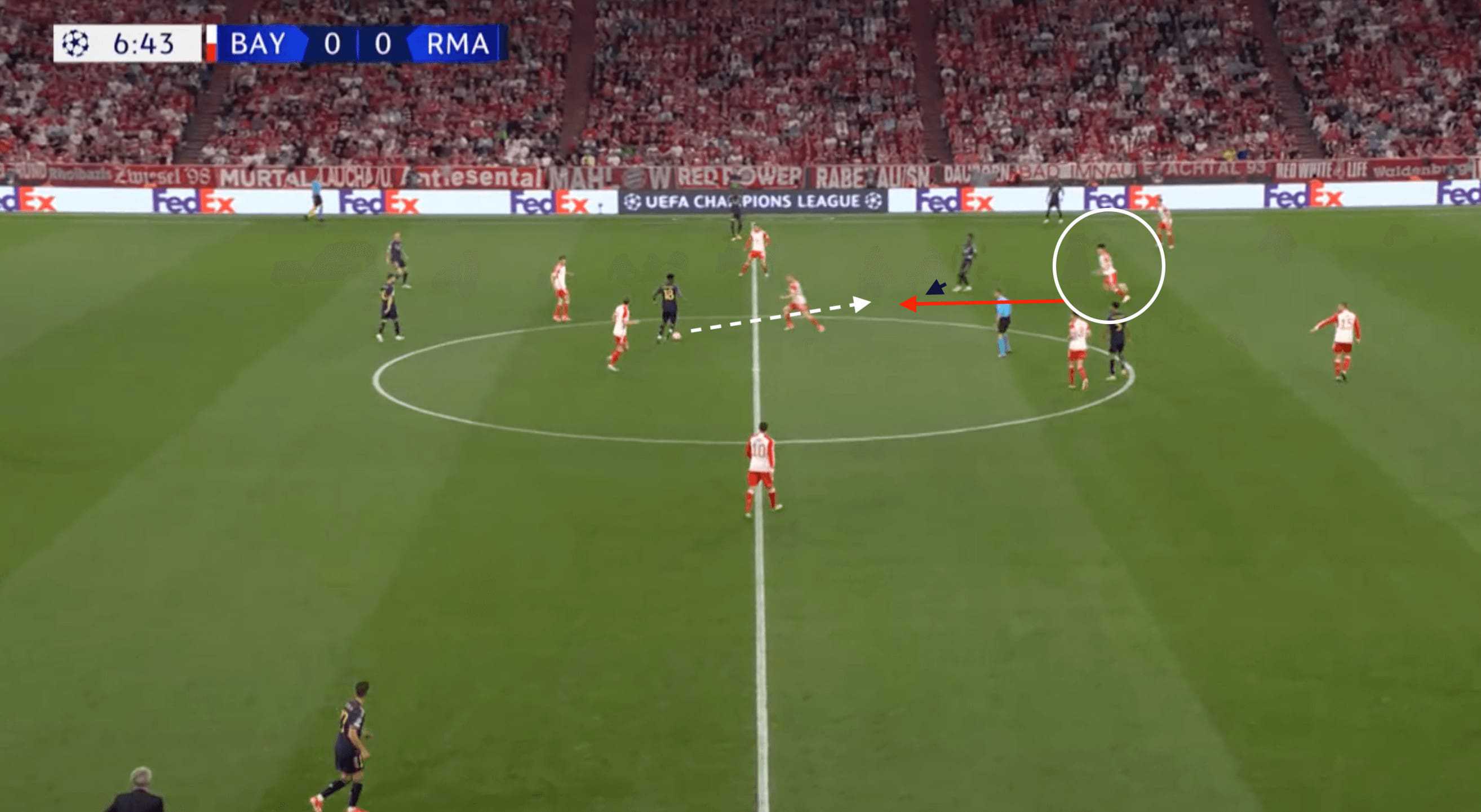
A look towards the second leg
Ahead of the return fixture in Madrid, the home advantage swings in favour of the Spaniards, with Bayern possibly ruing their missed opportunities with the tie level at 2-2.
The key to success was on display for both sides in the first fixture, but some alterations can be suggested, which would make both sides far more effective in such a huge match.
It would appear that the transitional phase is the killer for both teams, with Bayern first suffering from the electric nature of the Madrid forward line.
Despite persistent threats on the counter, Bayern were picked apart again and again by Vinícius and his ability to run beyond Kim in particular.
It is imperative for Bayern to negate space in behind, whether that is achieved by Neuer looking to play a tad higher or, probably more importantly, Bayern’s defenders being less press-heavy and weathering the Madrid storm with a resolute defensive performance.
For all their success in the attacking transitions, the effectiveness of Madrid’s forwards tracking back must improve if they want to nullify any Bayern attacking moves.
With reports emerging surrounding the fitness and health of Jude Bellingham before this week’s encounter, he may possibly be forgiven for a lack of defensive work, but Vínicius must exert the same level of energy when defending as he does when bearing down on the Bayern goal.
As we previously mentioned, Bayern’s midfield positioning does cause problems for Madrid’s marking assignments, but Vinícius’ inability to track Laimer allowed the Austrian to drive forward and spread the play to Sane for Bayern’s opener.

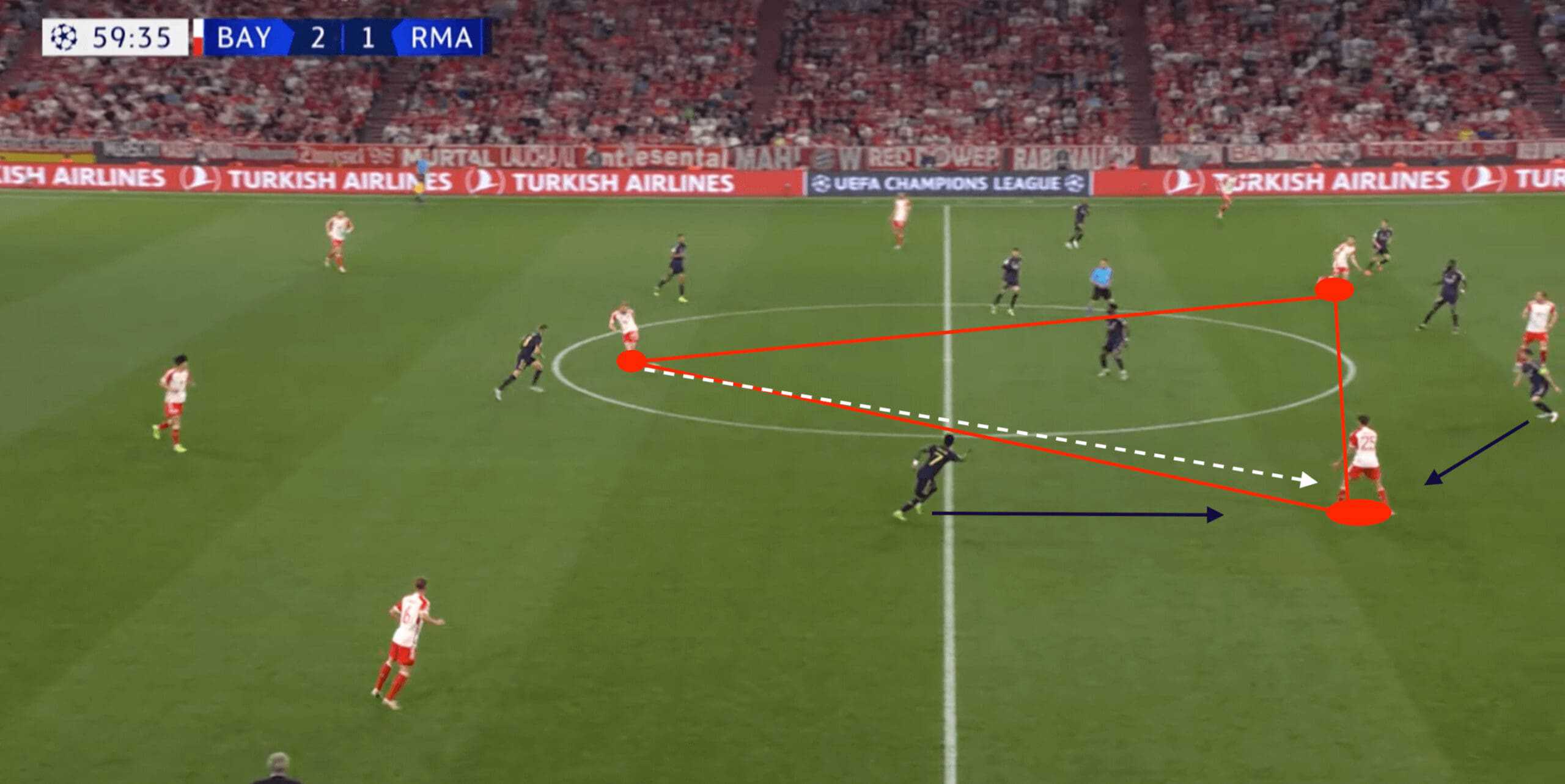



Comments